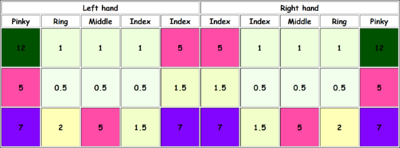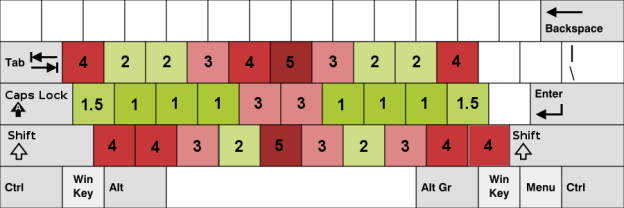I don't think your aggressive and dismissive tone is warranted, but anyway, to address your points:
davkol said:Assuming that finger strength is actually *the* important factor.
The model doesn't claim the finger strength is *the* important factor, it includes it as one factor amongst others. Yes, the assignment of relative strengths is subjective, a point I acknowledged, but I don't think it's controversial to say index fingers are strong, pinkies are weak, so the question at issue is to what extent and how it should be quantified. I also wish there were more good studies of keyboard use. If you are aware of a study that could better inform how to treat relative finger strengths, please post a link to it instead, at least that would be constructive...
davkol said:Consequently, motions that are transverse to the direction of the forearm are penalized more heavily
Wait, but why?
I'm increasingly convinced that these models have very little to connection to the way people [do/should] type. The fundamental observation is that typing is not a sequence of isolated keystrokes, but a complex dynamic process that is better represented by hand positions.
The lateral hand motion being more costly is not novel, but increasingly mainstream - the Colemak-DH and Workman layouts are both based around it, and there are plenty of people around who agree with this premise, so for those people including this is perfectly valid. I agree with your other point about sequences of keystrokes being significant, this keyboard effort grid is one part of a complete model, something I did mention on that page.
davkol said:[assume QWERTY labels] When a typist writes 'rt', why should they return their index finger to the home row between the two keystroke?
Again the model isn't saying that. Yes, it's assigning a value for each key representing the how easy it is to reach on average from the home position, which I'd argue is a useful piece of information to include.
For some reason you seem to think that unless people are able to recruit a team of typists and fund a huge study, that they shouldn't be allowed to think about and attempt to quantify what factors they think are relevant to typing efficiency and comfort based on a combination of their own experience, discussions with others, and the application of mathematics. I've critiqued many of the existing models that are out there previously, including the carpalx, workman and beakl ones - indeed, this piece of work is attempting to address some of what I see as some of the flaws and relevant but missing factors in other models.
Yes, it's just a model, no-one is claiming it's perfect. As with any model, the extent to which you accept its conclusions depends on how much you agree with its premises. People are free to agree or disagree with elements of the model, or suggest changes - it is still a WIP and I'm open to suggestions, hence my posting it here. No need to be triggered by it.
Last edited by stevep99 (22-Feb-2021 18:35:44)




